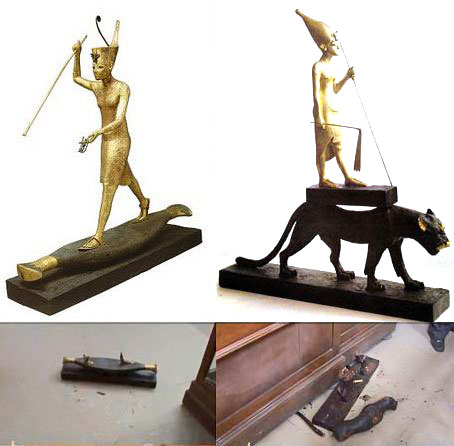The current protests in Egypt show us exactly how fragile the illusion of stability can be in the face of reality. It truly is astonishing that these ancient objects and sites have survived at all, across these thousands of years. It is breathtaking and utterly humbling to stand before a 3,500 year old wall bursting with vibrant color and clarity, and Egypt is such a global treasure precisely because it is one of those rare places where we have the ability to come so unabashedly face-to-face with the ancient.
In the current crisis, there is great inspiration for us all to be found in those many amazing Egyptians who formed a human protective chain around the Cairo Museum and those who are shielding the cultural treasures of the Theban region and elsewhere. These are humans at our best, guarding our shared heritage from the selfish looters who cannot see beyond themselves, and it turns out that most of us can be alarmingly good.
Ancient sites and objects are ephemeral in nature–did we not learn from the 2003 looting of the National Museum of Iraq or the destruction of the Bamiyan Buddhas in 2001? This fact is why the Art of Counting has fully embraced digital storage, online dissemination, social media, and professional crowdsourcing. Once we capture an an ancient site in digital format and share the data among the Art of Counting community, a new type of permanence is achieved on such a level as to rival that of the ancients. The data we’ve gathered can now outlive us all.
But we are in a race with time. Anything that has not been thoroughly photographed digitally (or otherwise converted into digital format) can be lost in a single looting or, more likely, to a reckless tourist.
Composite image of Tutankhamun statues in intact and current, damaged state (thanks to OsirisNet):
A selfish tourist fondling the painted walls at Deir el-Bahri:
Epigraphic surveys are fantastic resources but, particularly because of preserved color, are simply not enough. For quantitative analysis and binary permanence, we need everything to be digitally photographed or scanned. A bunch of 4×6 photos stored in a shoebox in an attic in some house in Germany or the dark recesses of an office in NYC are the same as no photographs at all, unless some freak accident brings their existence to light. This is a huge waste of effort and is frankly no better than having never collected the data in the first place.
The recording and dissemination mission of the Art of Counting cannot be achieved by our team alone. The job is too enormous for anything less than an army of photographers, videographers, statisticians, Egyptologists, and professions not yet envisioned to get it done. This immense task absolutely requires the collaborative efforts of a large collective to be successful.
Once proper digital recording of sites or objects has been achieved, information about these monuments can be entered into the shared database. The current database, focused on the temple of Ramses III at Medinet Habu, can (as a simple example) tell you in a matter of seconds exactly how many times pharaoh appears in a ‘smiting’ pose at the temple, which examples are connected to portals, the occurrences where pharaoh wields a mace rather than a scimitar, and those where he wears a Red Crown. In this baseline study, we’ve analyzed hundreds of variables and can instantly view the entire dataset from any angle and through the lens of any variable. But without color digital images, such data cannot be efficiently–or even adequately–captured.
The Art of Counting has decided in the face of recent events to increase our emphasis on the recording aspect of the project. We will begin assembling a target list of sites, monuments, and objects in need of full digital image documentation and pursue their recording. We are also actively seeking contributors who have private collections of such images and are willing to share and disseminate them among the community. This will not only allow wide access to these image collections, which provides obvious benefit for scholars, but would also prevent their loss in the event that a personal data storage device is damaged, stolen, or destroyed.
There is little more troubling to a historian than the unnecessary loss of our irreplaceable collective data! It is our responsibility as scholars to ensure that our work benefits those who follow us and allows them to build upon a reliable foundation; one of the worst things we can do instead is force others to repeat our efforts simply because our data is unavailable.
Join us!



